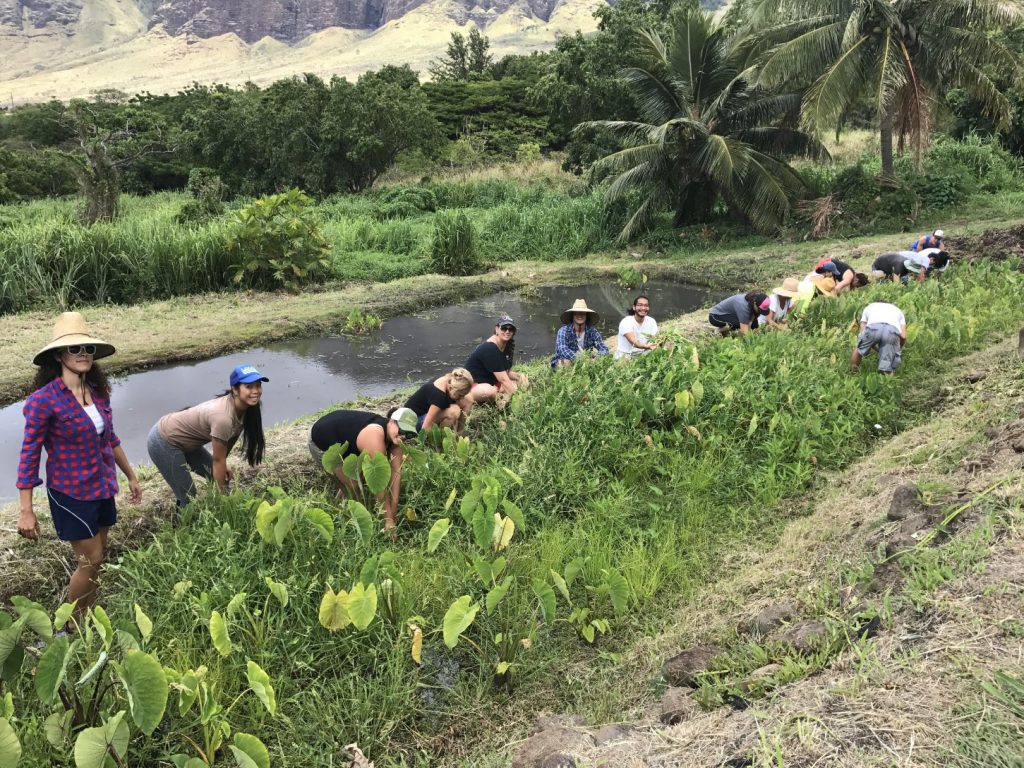
Politics of Water students working at Ka’ala Farm
Students in Dr. Monique Mironesco’s Politics of Water course recently learned first-hand about the importance of water access and use when they worked the loʻi at Kuhiawaho and Kaʻala Farm.
Students pulled weeds, plugged holes in loʻi walls and embankments, and removed invasive plants and species from the taro fields. The 17 students toiled for several hours at each venue and spent additional time talking with the caretakers of each loʻi.
The Politics of Water course is being offered for the first time this semester and examines water policies in Hawaiʻi, nationally, and globally. The class is a companion course to the long-running Politics of Food course. Politics of Water is a Political Science course cross-listed with Sustainable Community Food Systems.
During the semester students examine political protest and activism linked to the Na Wai Eha case on Maui, the environmental racism exhibited in Flint, Mich. drinking water controversy, and the Dakota Access Pipeline protest over indigenous peoples access to safe and fresh drinking water. They also study the privatization of water on a global scale to help them understand how water politics and policy is embedded in daily life.
The course also includes a service learning component, with students meeting at various water-related and education sites, according to Mironesco, an Associate Professor of Political Science. The work at Kaʻala Farm was a good example of students working in the loʻi (irrigated terrace) to get a close-up view of a water issue that affected cultivation of kalo (taro).
Kaʻala Farm’s website says water diversions for sugar left the Waiʻanae Valley without its natural streams, overrun by koa haole trees and invasive grass. But in the late 1970s a group of community members began working to bring water back to the Wai’anae Valley and restore the loʻi.
Kaʻala Farm is also a member of the Waiʻanae Mountains Watershed Partnership, which works to protect, restore, and enhance the mountains’ watersheds and has a mission of bringing people together to manage watersheds, native species and habitats, and historic, cultural and socio-economic resources for all who benefit from the health of the Waiʻanae ahupuaʻa.
“Ka’ala Farm is working to restore some of the water to the streams at its source,” said Eric Enos of Ka’ala Farm, explaining this includes the removal of invasive forest plants and reforestation of native forests and goes to the overall health of the community and ahupuaʻa. “The stream then feeds the lo’i in the upper-perched watershed. This water then goes back into the stream and recharges groundwater wells below the lo’i, which is then re-used for domestic water supply.”
Kuhiawaho is another example of the interplay between politics and water. Mironesco said the loʻi near Leeward Community College has access to several springs and faces different issues than Ka‘ala. Its proximity to Pearl Harbor with its prohibited access to civilians has resulted in a broken ‘auwai–a broken a connection between the lo‘i and the ocean.
The revitalization efforts at both sites demonstrate that rebuilding watersheds and promoting indigenous natural resource management are part of a movement toward community food and water security, according to Mironesco. The students are also performing service learning at sites elsewhere, including Paepae O Heʻeia, a working fishpond.
